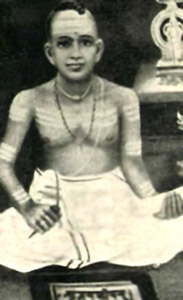 Narayana Bhattatiri was a Sanskrit author and the third student of Achyuta Pisharati. He belonged to a Namboodari Brahmana family from Melpathur situated on the north banks of the Bharathapuzha River in Kerala. His full name is Melpathur Narayana Bhattatiri. His father Mathrudattar was a great Mimamsa scholar himself. So, Narayana Bhattatiri took his first education in childhood from his father.
Narayana Bhattatiri was a Sanskrit author and the third student of Achyuta Pisharati. He belonged to a Namboodari Brahmana family from Melpathur situated on the north banks of the Bharathapuzha River in Kerala. His full name is Melpathur Narayana Bhattatiri. His father Mathrudattar was a great Mimamsa scholar himself. So, Narayana Bhattatiri took his first education in childhood from his father.
Narayana Bhattatiri later continued his further learning of Rig Veda from Madhava, Tarka Sastra from Damodara and Vyakarana (Sanskrit grammar) from Achyuta Pisharati. By the age of 16 years, he became a pundit. He became a mathematical linguist (vyakarana) and also got the membership of Madhava of Sangamagrama`s Kerala School of astronomy and mathematics. He got married to Achuta Pisharati`s niece and settled in Thrikandiyur.
Narayana suffered with rheumatism early in his life. He went to Guruvayur in Kerala and worshipped the deity to get recovered from the disease. He wrote the well-known `Narayaneeyam` at that time and he got cured. It was a devotional composition written in Sanskrit in the praise of Lord Krishna and is still sung at the temple where he worked. It was written in poetical form and consists of 1036 verses in twelve skandas. It gives a summary of 14,000 verses of the Bhagavata Purana and was written in 1586. It is said that he finished this work in 100 days by devoting one cantos (of 10 verses, known as `Dashakam` in Sanskrit) to the deity Guruvayoorappan on each day.
Narayana Bhattatiri got the patronage of Narayana, Devanarayana, known as Puratam Tirunal Maharaja was the most important. He has authored many Sanskrit works. He composed the `Panebalisvavamvara` in `champu` style, which is a work in prose and verse. This piece describes the `svayamvara` of Draupadi. It is written in a very simple and elegant style and do not have compounds and puns.
Another composition of Narayana Bhattatiri was the `Prakriyasarvasva`, a text on grammar. In this composition he attempted to rearrange the sutras of Panini for the benefit of beginners. A commentary `Nibhandana` on Rumania`s Tantravartika was also written by him. His work called `Matiatneyodaya` dealt with philosophy.
Narayana Bhattatiri was a very devoted student. There is a story related to his devotion. It is said that his guru Achyuta Pisharati was once attacked with paralysis. He was very much upset to see his guru in pain so by his yogic strength he took upon the disease on himself. It was his own way to offer `Gurudakshina`. Ezhuthachan, a contemporary Malayalam poet of him advised Narayana Bhattatiri to start eating fish to get rid of the disease. But for an orthodox strict vegetarian Brahman, the suggestion itself seemed to be very offensive. Bhattatiri got the hidden meaning of his words and began to present the various incarnations of Lord Vishnu, starting with the fish, as narrated in the Bhagavatham in a series of Dasakas.



















